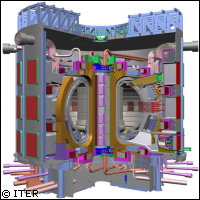Signing of first procurement arrangement marks ITER project progress
Signing a first procurement arrangement with Japan, the International Thermonuclear Experimental Reactor (ITER) organisation has just taken an important step in the construction process. As a member of the international joint venture, Japan will provide nine out of a total of 18 Toroidal Field (TF) Coils that will confine the plasma within the ITER machine. A further ten - including a spare - will be produced in Europe. The production of the coils, which require the use of cutting-edge technology, will involve manufacturing about 400 tons of niobium3-tin conductor cable, making it one of the largest superconducting cable procurements in history. 'The amount of material that is going to be manufactured is certainly unprecedented in its scale and it signals the first step to the construction of the ITER magnets,' Neil Mitchell, responsible officer for the ITER magnet system, explained. Some 90% of the components needed for ITER will be provided 'in kind' by ITER members. 'Being the first procurement arrangement, it clearly signals that ITER procurements have begun and on a big scale,' said ITER director general Kaname Ikeda. The signature was one of Mr Kaname's first official acts, as he had just been formally appointed as director general by the ITER Council, convening for the first time on 27 and 28 November in Cadarache, Southern France, the ITER project site. 'This meeting is a truly important day for fusion and for mankind, as it marks a major step towards the availability of the fusion as an environmentally responsible source of essentially limitless energy,' said Sir Chris Llewellyn Smith, who the Council elected as its chairman. The council meeting, convened by the International Atomic Energy Agency (IAEA) and bringing together scientific statesmen and stateswomen from all of the ITER countries, came a little more than a month after the ITER Agreement had entered into force on 24 October 2007. Sir Llewellyn Smith called the meeting 'a turning point' for the project: 'The design review showed that the ITER design is fundamentally sound, although the implications of some design choices and changes need to be studied further in the coming months. The stage is now set for major procurement activity in ITER members as well as the beginning of construction on the ITER site.' Once completed, ITER will be the world's largest fusion research facility, the aim being to develop a prototype fusion power plant that is safe and reliable as well as environmentally responsible and economically viable. The construction costs for the reactor are estimated at €5 billion over ten years, half of which will be contributed by Europe while the other half will come from the other project partners around the world (China, Japan, India, the Republic of Korea, the Russian Federation and the USA).



